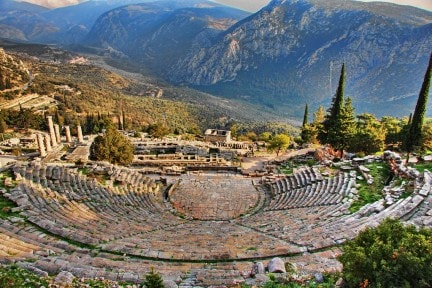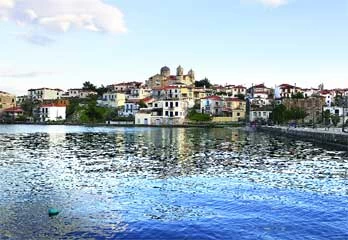Make your reservation now
Pick up

ARACHOVA TOUR

.jpg)

ARACHOVA is a stone village, just 8 km before the historic archaeological site of Delphi. Coming from Athens, shortly after entering the village you will find the right historic neoclassical building, a former elementary school, built in 1910 by Andrew Syggros, which has been restored by the City Arachova and used as an information center.
Just behind the former elementary school is the church dedicated to the Virgin Mary and in his backyard, you will find yourself under the Rock of Time or bell as the locals call it.
You can walk the paved narrow streets of the village and visit the church of St. George.
For the church of St. George, you can start from the small square with cafes and three stone fountains, and through steps (steps carefully enough!) To get to the churchyard.
From the courtyard of the view is breathtaking. It can be seen in the landscape to the bay of Itea and the tops of the Peloponnese.
Each year, Arahovitans honor their patron Saint George, organizing the Feast of St. George , which lasts three days full of events and sports activities for children from 2-99 years!
The ski resort of Parnassos, which dominates the village of Arachova has given at least for the winter splendor of one of the top destinations for most visitors. Splendid hotels, traditional Greek kitchen, fireplace and snow with the surroundings make the village of Arachova resemble fairy.



Hosios Loukas is situated on the western slopes of Helicon below the acropolis of the ancient town of Steiri, near the village of sterile, in Boeotia. It is one of the most important monuments of Middle Byzantine art and architecture and is included in the world heritage list of UNESCO, together with the other two surviving monasteries of the Middle Byzantine period in Greece, Nea Moni Monastery of Daphni. The Saint Luke is however larger and differs from Daphni Monastery and the New that is dedicated to a single Blessed, by Saint Luke in one of the finest.



DELPHI was an ancient Greek city in which worked the most important oracle in the ancient world. The city is mentioned by the Homeric times called Pytho. At the beginning of historical times was one of the ancient cities of Phocis, but gradually the city's role was strengthened and developed at the national center and the holy city of the ancient Greeks. It was also the center of the Delphic Amphictyony. Delphi maintained a significant position until the end of the 4th century AD, when it was finally clear to the oracle by decree of Emperor Theodosius. In the following centuries, the city declined and was finally abandoned in the period of the Slavic invasions.
Delphi is an area with a strong tourism and has been designated a UNESCO World Heritage Site of UNESCO. Besides the archaeological site and the museum, there is the European Cultural Centre and the surrounding area a number of monasteries of religious interest.



Galaxidi, characterized as a traditional settlement of 1978, Galaxidi has a stately beauty in traveling. The port also carries the glamor of the season was filled bratseres, lover and schooners anchored rows and women mend sails in one room specially equipped lounges on the first floor of the mansion. Almost a century later, life moves at other rates and Galaxidi is now a quiet town and ideal weekend destination for Athenians. The atmosphere of the past has remained intact thanks to the locals love for tradition and mild tourist development, with small guesthouses in beautiful restored mansions and tidy taverns, offering a sophisticated package. It can make a beautiful walk by the sea from the port to the wooded hill of hospitality school or on the other side to Chirolaka and climb drive to the monastery of the Savior to enjoy the view. Besides standalone destination for weekend, however, Galaxidi is a great ride for fish nearby for guests of Arachova.



The coastal town of Itea is located 13 km. Southern Amfissas embraced the Corinthian Gulf. Along with the neighboring Kirra is built deep in the Gulf Krissaiou.
Behind the Itea lies the picturesque grove of Amfissas, surrounded by the beautiful mountains of Parnassos and Giona, on which you can distinguish Delphi and Chrisso.
Itea is a new town that was established in 1830 and probably owes its name due to the many willows that grow in the area previously. Today, with a population of 9,000 inhabitants.
Itea is an important resort and the largest and most important port of the prefecture of Phocis. In the commercial port are loaded bauxite bauxite mines operating in the area. The ultramodern marina has been able berthing 250 vessels.


The Antikira famous for its beautiful beaches and the factory of Aluminium of Greece which is 10 minutes.The current name Antikira took in 1929 while the oldest "Aspra Spitia" revives the new settlement created Antikiras east.
A beautiful and picturesque coastal town of ancient Phocis, which is a safe harbor on the northern coast of the Corinthian Gulf. The port has the capacity mooring small boats with power and water and the jetty offers protection from all winds.
The first port of Agios Isidoros beach is considered a haven for fishing boats and the boats in the event of rough seas and bad weather.
The beach of Agios Isidoros is awarded the blue flag and you can enjoy a swim in the hot days of summer, and the new port beach in Koutrou.
Visitors can enjoy swimming in the sea or in the Antikira either the two beaches of St. Isidore, which rises over the years
the blue flag, or an end to the new beach "port Koutrou".
Even in the taverns and restaurants will find fresh local fish and has the potential recreational fishing and snorkelling, as well as various other marine pursuits.



Nafpaktos: A city jewel
Built between Antirrio and estuary Mornou our waiting beauties Etoloakarnanias. The idyllic beaches overlook the calm waters of the Corinthian Gulf ∙ charm encircles the mountain paradise of Nafpaktos ∙ great history reflected in two important monuments: the lush Venetian castle and the Venetian harbor.
Arriving in Nafpaktos first impressions gained by wide streets, shaded by broad-leaved trees, traditional corners and a crowd of people of all ages to enjoy carefree autumn sunshine in outdoor restaurants and cafes by the sea. We start our tour in the city with a leisurely stroll through the cobbled streets with many nautical houses and well-kept mansions. Tufted and colorful bougainvillea flowers adorn the stone walls flooding the friendly neighborhood with all sorts of colors and aromata.Oloi roads leading to the port, the smallest and most beautiful of the Mediterranean! The eastern tower welcomes us old sailor lighthouse and the Fethiye Mosque, built in 1499 The marble plaque reminds us of the famous naval battle of Lepanto, in 1571 In the western arm, next to iron cannons marking the sea, lies the statue of the legendary congressman George Anemoyiannis and the statue of the famous Spanish author Miguel de Cervantes. The perfect "excuse" for a few hours rest are the Delights ahead of the pedestrian Stenopazarou, where was the old market with its taverns duly honored local people and workers of the port ...
With renewed forces begin the ascent to kastro- of the best preserved forts with five diazomata- whose history begins in ancient times all the way to the Turks. Climbing on top -in 'triple tiara of Lepanto », as it was called by the Venetians - our nails the unsurpassed views across the city, the port and the Corinthian bay with stunning cable stayed bridge of Rio - Antirrio looming on the horizon. The picturesque chapel of Prophet Elias (11th century), the clock - bell tower and the ruins of the Ottoman bath earn our attention.











